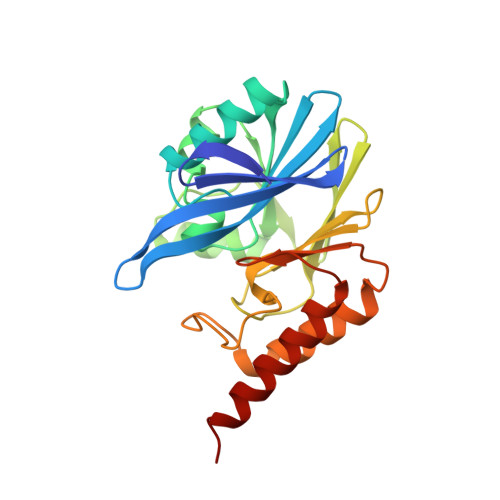X-ray structure of the ZnII beta-lactamase from Bacteroides fragilis in an orthorhombic crystal form.
Carfi, A., Duee, E., Paul-Soto, R., Galleni, M., Frere, J.M., Dideberg, O.(1998) Acta Crystallogr D Biol Crystallogr 54: 45-57
- PubMed: 9761816
- DOI: https://doi.org/10.1107/s090744499700927x
- Primary Citation of Related Structures:
2BMI - PubMed Abstract:
beta-Lactamases are extracellular or periplasmic bacterial enzymes which confer resistance to beta-lactam antibiotics. On the basis of their catalytic mechanisms, they can be divided into two major groups: active-site serine enzymes (classes A, C and D) and the ZnII enzymes (class B). The first crystal structure of a class B enzyme, the metallo-beta-lactamase from Bacillus cereus, has been solved at 2.5 A resolution [Carfi, Pares, Duée, Galleni, Duez, Frère & Dideberg (1995). EMBO J. 14, 4914-4921]. Recently, the crystal structure of the metallo-beta-lactamase from Bacteroides fragilis has been determined in a tetragonal space group [Concha, Rasmussen, Bush & Herzberg (1996). Structure, 4, 823-836]. The structure of the metallo-beta-lactamase from B. fragilis in an orthorhombic crystal form at 2.0 A resolution is reported here. The final crystallographic R is 0.196 for all the 32501 observed reflections in the range 10-2.0 A. The refined model includes 458 residues, 437 water molecules, four zinc and two sodium ions. These structures are discussed with reference to Zn binding and activity. A catalytic mechanism is proposed which is coherent with metallo-beta-lactamases being active with either one Zn ion (as in Aeromonas hydrophila) or two Zn ions (as in B. fragilis) bound to the protein.
- LCM, Institut de Biologie Structurale Jean-Pierre Ebel (CEA-CNRS), Grenoble, France.
Organizational Affiliation:


















